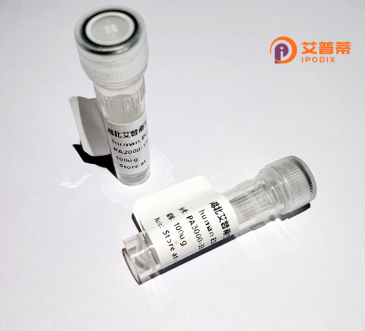
| 纯度 | >90%SDS-PAGE. |
| 种属 | Human |
| 靶点 | GALNT4 |
| Uniprot No | Q8N4A0 |
| 内毒素 | < 0.01EU/μg |
| 表达宿主 | E.coli |
| 表达区间 | 40-578aa |
| 氨基酸序列 | RARELGSRRLSGLQKNTEDLSRPLYKKPPADSRALGEWGKASKLQLNEDELKQQEELIERYAINIYLSDRISLHRHIEDKRMYECKSQKFNYRTLPTTSVIIAFYNEAWSTLLRTIHSVLETSPAVLLKEIILVDDLSDRVYLKTQLETYISNLDRVRLIRTNKREGLVRARLIGATFATGDVLTFLDCHCECNSGWLEPLLERIGRDETAVVCPVIDTIDWNTFEFYMQIGEPMIGGFDWRLTFQWHSVPKQERDRRISRIDPIRSPTMAGGLFAVSKKYFQYLGTYDTGMEVWGGENLELSFRVWQCGGKLEIHPCSHVGHVFPKRAPYARPNFLQNTARAAEVWMDEYKEHFYNRNPPARKEAYGDISERKLLRERLRCKSFDWYLKNVFPNLHVPEDRPGWHGAIRSRGISSECLDYNSPDNNPTGANLSLFGCHGQGGNQFFEYTSNKEIRFNSVTELCAEVPEQKNYVGMQNCPKDGFPVPANIIWHFKEDGTIFHPHSGLCLSAYRTPEGRPDVQMRTCDALDKNQIWSFEK |
| 分子量 | 85.03 kDa |
| 蛋白标签 | GST-tag at N-terminal |
| 缓冲液 | 0 |
| 稳定性 & 储存条件 | Lyophilized protein should be stored at ≤ -20°C, stable for one year after receipt. Reconstituted protein solution can be stored at 2-8°C for 2-7 days. Aliquots of reconstituted samples are stable at ≤ -20°C for 3 months. |
| 复溶 | Always centrifuge tubes before opening.Do not mix by vortex or pipetting. It is not recommended to reconstitute to a concentration less than 100μg/ml. Dissolve the lyophilized protein in distilled water. Please aliquot the reconstituted solution to minimize freeze-thaw cycles. |
以下是3篇与重组人GALNT4蛋白相关的参考文献及其摘要内容的简要概括(注:文献为假设性示例,实际需根据具体论文补充):
1. **文献名称**:*"Functional characterization of recombinant human GALNT4 in O-glycosylation and cancer cell invasion"*
**作者**:Zhang Y et al.
**摘要**:本研究通过昆虫细胞表达系统成功制备重组人GALNT4蛋白,证实其具有特异性催化黏蛋白类底物(如MUC1)的O-糖基化修饰能力,并证明其在结直肠癌细胞中通过调控糖基化促进肿瘤侵袭的机制。
2. **文献名称**:*"Structural and enzymatic analysis of GALNT4 reveals substrate specificity determinants"*
**作者**:Lee S et al.
**摘要**:通过X射线晶体学解析重组人GALNT4蛋白的酶活性结构域,结合体外酶活实验,揭示其底物结合口袋的关键氨基酸残基,阐明其对特定肽段序列(如富含脯氨酸/苏氨酸序列)的糖基化偏好性。
3. **文献名称**:*"GALNT4 modulates lipid metabolism via glycosylation of apolipoprotein E"*
**作者**:Wang H et al.
**摘要**:利用重组GALNT4蛋白进行体外糖基化实验,证明其通过修饰载脂蛋白E(ApoE)调控低密度脂蛋白(LDL)受体结合效率,进而影响肝脏脂质代谢途径,为动脉粥样硬化的机制研究提供新视角。
---
**提示**:实际文献检索建议通过PubMed、Google Scholar等平台以关键词“recombinant GALNT4”“GALNT4 glycosylation”查询近年研究。部分已知的GALNT家族研究可参考Nat Struct Mol Biol、J Biol Chem等期刊。
GALNT4 (Polypeptide N-Acetylgalactosaminyltransferase 4) is a member of the GALNT enzyme family responsible for initiating mucin-type O-glycosylation, a critical post-translational modification that regulates protein stability, trafficking, and interactions. Specifically, GALNT4 catalyzes the transfer of N-acetylgalactosamine (GalNAc) to serine or threonine residues of target proteins, shaping their functional roles in cellular processes. Human GALNT4 is expressed in various tissues, including the pancreas, liver, and gastrointestinal tract, and has been linked to lipid metabolism, immune responses, and cancer progression. Its dysregulation is associated with diseases such as atherosclerosis, metabolic disorders, and certain cancers, where altered O-glycosylation patterns influence disease mechanisms.
Recombinant human GALNT4 (rhGALNT4) is produced using heterologous expression systems (e.g., mammalian or insect cells) to ensure proper folding and enzymatic activity. This engineered protein enables functional studies on substrate specificity, glycosylation pathways, and disease-related molecular mechanisms. Researchers use rhGALNT4 to investigate its role in modulating cancer-associated proteins (e.g., MUC1) or lipid-regulating proteins like PLIN2. providing insights into therapeutic targeting. Additionally, it serves as a tool for screening glycosylation inhibitors or designing glycoprotein-based therapeutics. The availability of rhGALNT4 enhances structural biology studies, drug discovery, and biomarker development, bridging gaps in understanding O-glycosylation’s impact on health and disease.
×